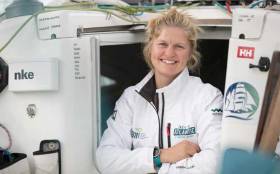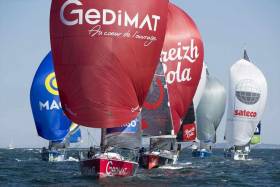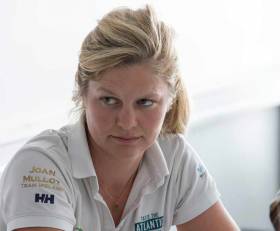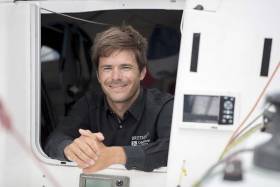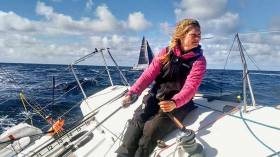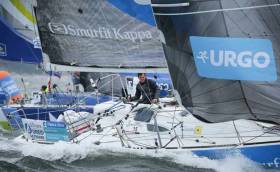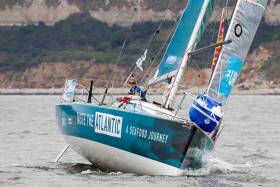Displaying items by tag: Joan Mulloy
Joan Mulloy Lying 27th After Two Legs of La Solitaire Le Figaro
Just seconds before the start of leg 2 in La Solitaire Urgo Le Figaro, Mayo’s Joan Mulloy suffered gear failure that saw her mainsail come crashing down. Luckily, the rules allow for outside assistance to make repairs before a certain point and she spent the remainder of the race playing catch up as the fleet raced across the Bay of Biscay towards Spain.
The setback put Mulloy 3 hours and 20 minutes behind the ultra-competitive fleet as they left the French town of Saint-Brieuc. Meath’s Tom Dolan on his yacht Smurfit Kappa stuck with the group for most of the race and finished in 29th place out of 36 largely French entrants. Mulloy clawed back two places and managed to finish 34th.
Speaking on arrival in Ría de Muros e Noia, Mulloy said, "I had to push really hard for the first 24 hours after the start because of the halyard problem. I had to pull in and get the halyard replaced. I did not sleep at all on the first night and just was chasing, chasing all the time. I was just thinking 'I can do it, I can do it, I can do it’. Every single bay and rock, I was just trying to squeeze the most out of everything. I was just totally determined to be with the pack before Biscay.”
Mulloy and Dolan are the only two Irish entrants in what is considered the most competitive offshore solo race series in the world. In France, it is a firm fixture for aspiring round the world racers with dreams of the Vendée Globe. The most experienced will dedicate years to La Solitaire Urgo Le Figaro before progressing to larger boats. Both Mulloy and Dolan are considered ‘Rookies’ as it is their first year competing.
Speaking about the Bay of Biscay Mulloy said: “Biscay was fine 30 knots (of wind) and bumpy, but I think all the time my mind was on Finisterre. It was hard not knowing how I was getting on with the rest of the fleet.”
After two legs Mulloy is lying 27th and Dolan is in 31st following his retirement in leg 1. Leg 3 of this 4 leg series starts on Saturday leaving just a few days for the fleet to recover. The next leg will see the fleet return to French waters ahead of the final leg, a 24 hours sprint that will bring this years event to a conclusion.
Joan Mulloy Makes Up Lost Places in Two-Part Figaro Fleet
Joan Mulloy, the first Irishwoman to take up the Figaro Solo challenge in France, has gained a couple of places racing Taste the Atlantic in the second day of Stage 2 to northwest Spain, after being delayed by a broken main halyard at the start off Sain-Brieuc writes W M Nixon. But Tom Dolan in Smurfit Kappa, having been up at 12th and within 1.5 miles of the leader, has slipped down the rankings through choosing to take the westerly option in the tricky waters between Ushant and the west coast of Brittany.
Anyone who has ever cruised this island-dotted, rock-strewn and tide-riven piece of the ocean will find it a marvel that people are racing single-handed through the midst of it with 36 powerful sailing machines under full spinnaker. But that’s part of the fascination of the way the Figaro race – now with the URGO organisation as co-sponsors - has developed as it works through the count-down towards its Golden Jubilee next year, when the third generation boats - foiling Figaro 3s - will be introduced.
Meanwhile, the Marc Lombard-designed Figaro 2 is centre stage in 2018 for the last time with style and nostalgia, and approaching the northwest point of Brittany at Lampaul early this afternoon, Gildas Mahe was leading. But he elected to continue offshore towards Ushant, while his closest challenger Anthony Marchand – the local hero after winning Stage 1 from Le Havre to his home port of Saint-Brieuc – gybed over to hold south down the coast.
The fleet had soon split into two distinct groups, and it was the inshore racers – led by Marchand and Pierre Leboucher – who did best, for as they have emerged into more open water well west of the Ile de Seine, the inshore group hold the first 15 places with its leaders shown as 5.2 miles clear ahead of the leaders of the offshore division, which included Tom Dolan with his placing now fluctuating in the 20s.
With winds steady from the northeast, progress is now more or less on rails, with any gains being fractional and hard-earned. The indications are that the mainly nor’east winds will continue across the Bay of Biscay. But the possibility of a low-pressure area developing over northwest Spain could make things more complex towards the finish, with a tricky beat into the Ria de Muros and up to the finish at Portosin being a final challenge for exhausted sailors.
Race tracker here
Joan Mulloy Delayed By Broken Halyard, Tom Dolan 12th After First Night of Figaro Stage 2
A broken main halyard at the start delayed Joan Mulloy’s departure yesterday in Stage 2 of the Solitaire URGO Figaro 2018, but Ireland’s other entry Tom Dolan is snapping at the heels of the top ten in this Stage, which started yesterday off St Brieuc in Northern Brittany and crosses the Bay of Biscay to northwest Spain writes W M Nixon. With fair mainly east to northeast winds off the French coast, the turning of the tide later favoured an inshore course , and the fleet are tacking to lee this morning off Brittany’s northwest corner, with Gilda Mahe (Breizh Cola) in the lead at Pointe de Pontuseval, 1.3 miles ahead of Stage 1 runner-up Charlie Dalin, and 1.5 ahead of Stage 1 winner Anthony Marchand back in third.
Tom Dolan’s current twelfth has him in close contact with top contenders such as Seabastien Simon (currently 7th) Hugh Brayshaw (8th) and Alan Roberts (5th). The first night has been a matter of catch-up for Joan Mulloy after her main halyard was replaced by her shore team, and she is further eastward along the coast, currently close west of the Ile de Batz and shown as 36th.
Race Tracker here
Joan Mulloy & Tom Dolan on RTE 'Seascapes' Tonight
Ireland’s solo Figaro sailors Joan Mulloy and Tom Dolan will be the focus of tonight's episode of RTE Radio 1’s Seascapes. Presenter Fergal Keane travelled to France to catch up with the skippers, teams, and sponsors ahead of leg 1 of La Solitaire Urgo Le Figaro.
On the show will be the two skippers, Ireland’s only ever entrant in the Vendée Globe and Atlantic Youth Trust President Enda O’Coineen, we’ll hear why Smurfit Kappa decided to sponsor Tom Dolan, and Team Ireland's Marcus Hutchinson will give an insight into this incredible race.
Listeners will also hear Joan Mulloy speaking on the dock at 3am after spending three and a half days alone at sea on her yacht 'Taste the Atlantic - A Seafood Journey'. The show airs at 22:30 on RTE Radio 1 and will be available online.
Joan Mulloy: 'A Wee Bit Disappointed' to Finish 27th in First Leg of Le Figaro Race
At 03:00am this morning, County Mayo’s Joan Mulloy crossed the finish line of the first leg of one of the most competitive solo sailing races, La Solitaire Urgo Le Figaro. Mulloy is the first Irish female to compete in this famous race. Mulloy placed 4th out of the 8 Rookies and 27th overall from 36. Speaking about her performance Mulloy said: “I am disappointed in the result a wee bit, but then you just have to look at what our goals were at the start of the year and where we are now, it is great to have been on the start line and now at the finish line.”
Speaking on arrival as she stepped off her boat ‘Taste the Atlantic - A Seafood Journey’, Mulloy said: “I’m totally zonked, the intensity, and the length of it. Three and a half days is a long time to constantly have your foot on the pedal. I loved it, I felt really well prepared, and we felt really well prepared as a team and I had fun!”
The gruelling three and a half day race started in the French port of Le Harve and finished off Saint Quai Portrieux in France. The fleet raced across the English channel battling 30+ knot winds only to be becalmed as the made their way towards a lighthouse off the southwest tip of England. 36 identical 32ft yachts crossed the starting line but the punishing conditions saw seven skippers forced to retire including Ireland’s Tom Dolan.
On Sunday Mulloy will be starting leg 2 of this 4 leg race. When asked what her priorities were during that time she said: “Sleep, have a bath and eat food!”
Leg 2 will see the fleet crossing the notorious Bay of Biscay to finish in the Spanish town of Ría de Muros-Noia 520 miles later.
Figaro First Stage Finish to be a Real Nail-Biter
The first shortened stage of La Solitaire URGO Figaro is speeding to a finish tonight off St Brieuc with less than a mile separating the leading dozen boats as they drag race along the rocky North Brittany coast in a welcome nor’west breeze. Alan Roberts of Scotland in fifth place is currently best of the non-French entries, but another helm from the Marcus Hutchinson stable, Hugo Brayshaw, is close astern in the tight-packed leading group.
Even though there are less than thirty miles to the finish and they’ve been hitting ten knots and better, it will be dark by the time they get to the line, and with the onset of evening, there’s a likelihood the breeze will ease. Currently, Anthony Marchand leads by 0.2 miles from Thierry Chabagny and Charlie Dalin, but the final downwind stretch will probably see another reshuffling of the pack.
Ireland’s Joan Mulloy has closed up on the leading group but is still 18.2 miles astern, making 9.2 knots in 27th place.
Race tracker here
Sudden Shortening of Course in La Solitaire URGO Le Figaro
This morning as the leaders in of La Soliatire URGO Le Figaro were approaching the southwest turning point of Stage 1 at Grand-Basse de Portsal off northwest Brittany, the Race Director informed them by VHF that he was shortening the course. Under the new instructions, they were no longer to complete 543 miles by racing to Saint-Brieuc by way of Guernsey, but instead were to race a total of 475 by going to the finish directly along the rocky and tide-riven north coast of Brittany reports W M Nixon.
Judging by some of the traces showing on the Race Tracker, two or three of the boats seem to be unaware of the change. But Alan Roberts, the Marcus Hutchinson-mentored Scottish sailor who first honed his skills in top-level dinghy racing, took on the fresh challenge with enthusiasm, and having been in or around third place for most of the cross-channel leg from the Wolf Rock, he went furthest inshore on the new beat, but on re-joining the main group, found he had slipped to 8th while Sebastien Simon once again has taken the lead.
Ireland’s Joan Mulloy, currently placed at 27th out of 36 starters, has still to pass the Portsal mark.
Race tracker with new course here
Beware the Wolf Rock – Figaro Racers Find it a Tricky Turn
Light southerly winds and tricky tides have provided a challenging scenario for the leaders in La Solitaire URGO Figaro as they battled to round the isolated Wolf Rock to the southwest of Land’s End this afternoon writes W M Nixon. It was something of a melee, but Scottish sailor Alan Roberts – one of the Marcus Hutchinson academy – did well out of it, moving rapidly up the top ten to be in contention for third place as the long cross-Channel leg to the turn point off northwest Brittany began with a beat.
That beat may soon become a reach, but whatever the wind direction takes up, for the time being it doesn’t look like there’ll be a lot of it. It’s becoming one slow race after two days and five hours since the start, and heading into the third night the current leader Sebastien Simon racing Bretagne CMB Performance has managed to get 0.2 of a mile ahead of former leader Corentin Douget.
With Tom Dolan now re-positioning himself to St Brieuc for the second leg (starting Sunday) after his forced retiral with a spreader adrift, Ireland’s sole representative Joan Mulloy has been finding better speed to get herself west of the Lizard Point, and the most recent postings show her at 26th out of 36 starters.
Race tracker here
Tom Dolan Out of Figaro Leg One, Joan Mulloy Battles On
Unfortunately, Stage 1 of his La Solitaire URGO Le Figaro only lasted about 90 minutes for the Irish solo racer Tom Dolan yesterday. He has been forced to retire in to Le Havre because of a damaged starboard spreader. Dolan informed the race organisers that he was returning to the race start port where he is expected to repair and head directly to Saint-Brieuc to be ready for Stage 2. Abandoning the leg means his elapsed time is calculated at that of the last skipper to finish plus an additional two hours.
Listen into Tom Dolan speaking about the spreader failure on podcast here.
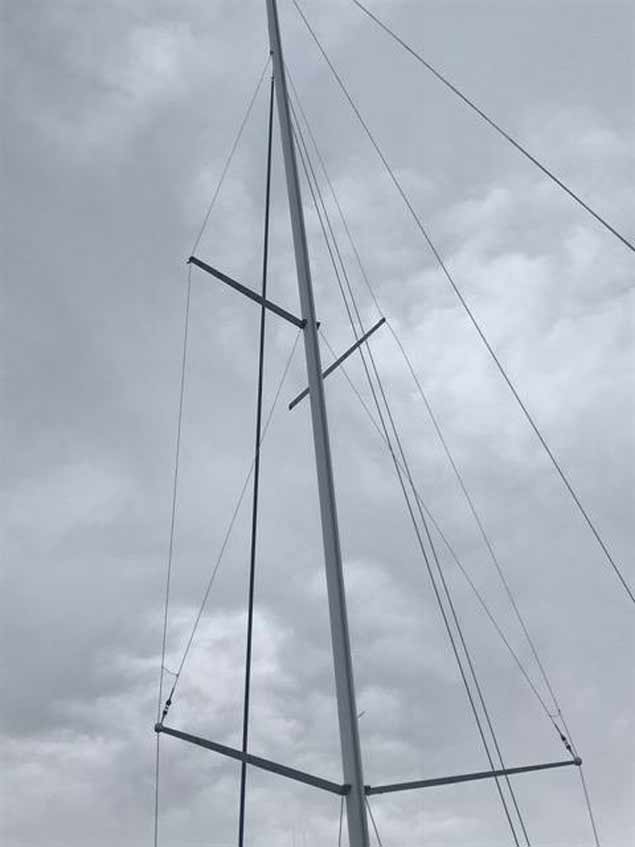 Dolan's broken spreader in Le Havre port last night. The breakage gave the County Meath sailor no choice but to retire and make repairs for leg two.
Dolan's broken spreader in Le Havre port last night. The breakage gave the County Meath sailor no choice but to retire and make repairs for leg two.
Meanwhile, Joan Mulloy, Ireland's first female in the race is currently lying 29th from 30 still racing. See tracker here.
The first stage of this 49th edition, La Solitaire URGO Le Figaro, is the longest of the four legs and it will be something of a baptism of fire for the 36 solo racers. They may have a relatively straightforward first afternoon after the start Sunday at 1300hrs but there will be a fast crossing of the Channel under spinnaker as a fast moving and active front passes over the fleet at the start of this evening.
It will be a pretty tough, challenging first night at sea with little chance to rest. But by Monday afternoon it there will be a big change in the weather as the anticyclone re-establishes itself and with that comes a measure of uncertainty, bringing light and unsteady winds. To get to Wolf Rock off the tip of Cornwall first and then across to the Portsall mark off the Breton peninsula in good shape, up to Guernsey and in to the finish in Saint Brieuc, it looks like a long, hard and very open game.
Only six and a half hours after leaving the La Solitaire URGO Le Figaro start line in Le Havre the leaders have already turned west, upwind at the Pullar mark, to the west of Owers. Anthony Marchand (Groupe Royer-Secours Populaire) lead at South Pullar at 1930h French time (1830 BST) being chased hard by Gildas Mahe (Breizh Cola), Tanguy le Turquais (Everial), Sebastien Simon (Bregagne Credit Mutuel Performance), Eric Peron (Finistere Mer Vent), Xavier Macaire (Groupe SNEF )and Vincent Biarnes (Baie de Saint-Brieuc). Brit Alan Roberts (Seacat Services) is tenth at 1.3nm behind leader. The fleet now race upwind leaving the Isle of Wight to starboard. Low water at Saint Catherine's point was around 1720 BST/1820 French time and so they will be sailing against the building flood tide.
Solo Queen Figaro 2’s Farewell Tours Show Style & Quality
First unveiled in 2003 as the new boat for the 1970-founded Figaro Solo Series, the Marc Lombard-designed 34ft Figaro 2 is a class act writes W M Nixon. But with the last one built in 2015, and replacement by the foil-sporting Figaro 3 well underway for next year, the versatile Figaro 2’s days at the sharpest edge of offshore racing are numbered.
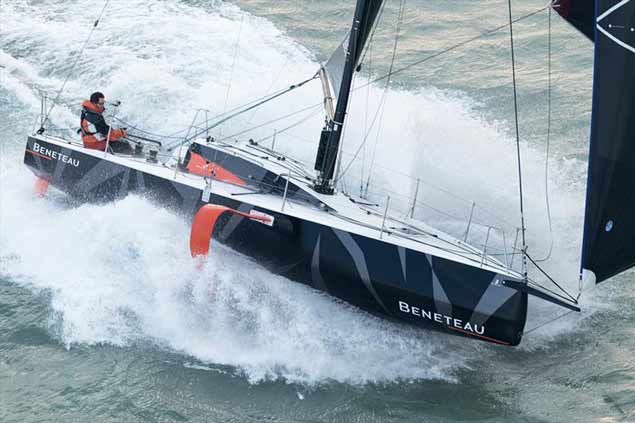 The Figaro 3’s foiling configuration will become a full part of the Figaro Solo story in 2019
The Figaro 3’s foiling configuration will become a full part of the Figaro Solo story in 2019
Or are they? Though she carries a tough IRC rating, the Figaro 2 can sail up to it, as has been revealed in the RORC Sevenstar Round Britain and Ireland Race. The tail-enders in that boat-breaking marathon are still struggling in light winds towards the finish in the Solent. But in the two-handed division, Volvo Ocean race veterans Benjamin Schwartz and Chen Jin Hao with their Figaro 2 El Velosolex SL Energies Group are long since finished, and they’ve made quite a clean sweep of it – first in 2-handed, first in IRC 2, and 2nd in IRC Overall.
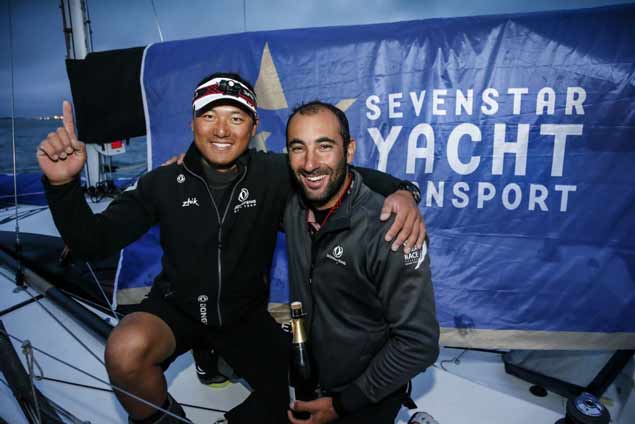 Chen Jin Hao and Benjamin Schwartz after winning the Two-Handed Division and placing second overall in the RORC Sevenstar Round Britain and Ireland race.
Chen Jin Hao and Benjamin Schwartz after winning the Two-Handed Division and placing second overall in the RORC Sevenstar Round Britain and Ireland race.
This made it an event to remember for Marc Lombard, as he also designed Guy Redpath’s Lombard 46 Pata Negra which won IRC overall and is also rated as the line honours winner. For although Class 40 sailed the same course with Phil Sharp’s Imerys Energy first to finish of the entire fleet, as far as the RORC were concerned it was the IRC Divisions which were the real race, and they made Pata Negra (third in fleet) the recognised line honours victor.
That in turn made El Velosolex second in line honours, But even in the complete fleet with Class 40 included, she was fifth on the water across the finishing line, a brilliant performance by two hyper-tough guys with a now classic boat which happened to be the smallest in the fleet.
This very special boat comes centre stage again on Sunday, with her final time as the boat-of-choice for the staging of the four part URGO Figaro Solitaire from Le Havre, and we’ll be looking at the prospects for Irish skippers Joan Mulloy and Tom Dolan here very shortly. But for now, after the series is over, what then for the Figaro 2 after she has completed these impressive Farewell Tours??
Doubtless most of the boats have already been earmarked for new owners who will know they’re getting a bargain. Trouble is, in future seasons this will be a “No Excuses Sailing Machine”. In an open fleet against more ordinary craft, there’ll be no excuse for not doing well.



























